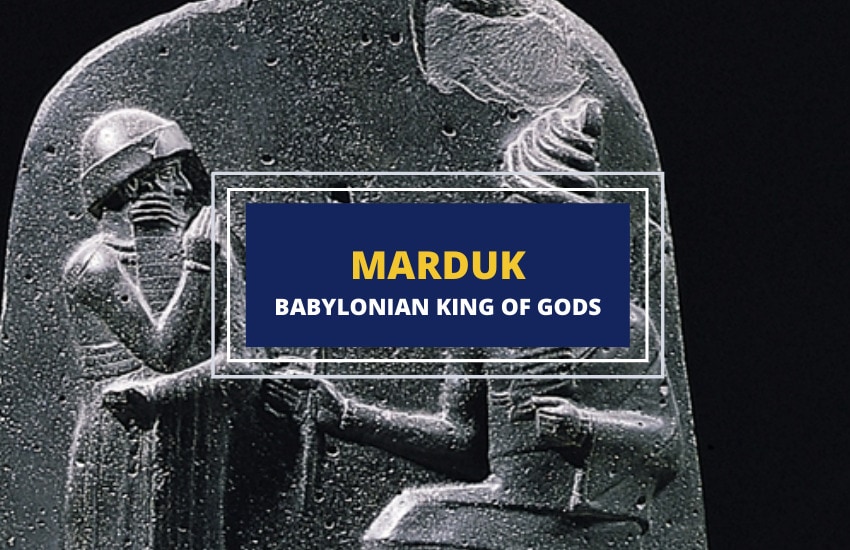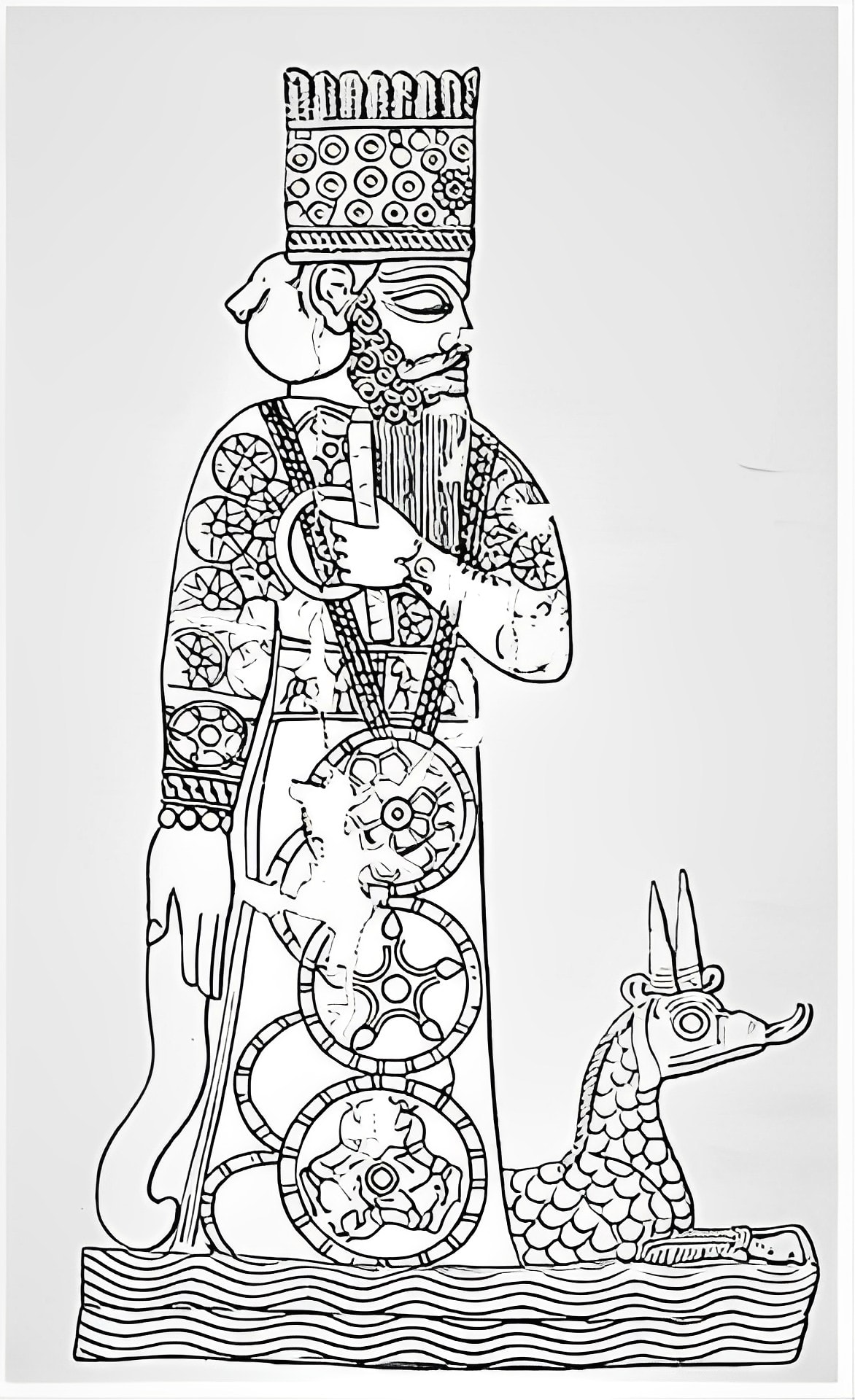
Table of Contents
Markduk was the chief deity of the Mesopotamian region, worshipped during the 2nd millennium BCE. Beginning as a god of storms, he rose in prominence during the time of the Babylonian empire to become king of the gods by the time of the reign of Hamurrabi in the 18th century BCE.

Facts About Marduk
- Marduk was the patron god of the city of Babylon and was seen as its protector.
- He was also called Bel, which means the lord.
- Marduk was associated with Zeus and Jupiter by the Greeks and Romans respectively
- His worship became associated with the planet Jupiter.
- He was the god of justice, Magic, creation, water, and agriculture.
- He is often depicted standing next to or riding upon a dragon. A myth exists of Marduk defeating the dragon Mushussu, a mythological creature with scales and hind legs.
- The story of Marduk is recorded in the Mesopotamian creation myth Enuma Elish.
- Marduk is typically portrayed as a man.
- Marduk’s symbols are the spade and the snake-dragon.
- Marduk battles the monster Tiamat, who personified the primordial sea which birthed the gods.
The Background of Marduk
Early texts from Mesopotamia indicate that Marduk was derived from a local god known as a Marru, who was worshiped for agriculture, fertility, and storms.
During Babylon’s ascent to power in the ancient world around the Euphrates, so too did Marduk grow in power as the patron saint of the city. He eventually would become the king of the gods, responsible for all of creation. He took over the position previously held in the region by the fertility goddess Innana. She continued to be worshiped, but not on the same level as Marduk.
Marduk became so well known in the ancient world that there is mention of him outside of Babylonian literature. He is explicitly referenced in the Hebrew Bible along with other references to his title Bel. The prophet Jeremiah, writing against the invading Babylonians, states, “Babylon is taken, Bel is put to shame, Merodoch [Marduk] is dismayed” (Jeremiah 50:2).
Enuma Elish – Babylonian Creation Myth

According to the ancient creation myth, Marduk is one of the sons of Ea (called Enki in the Sumerian myths). His father Ea and his siblings were the offspring of two water forces, Apsu, the god of fresh waters, and Tiamat, the tyrannical sea-serpent deity and personification of the primordial sea from which the gods were created.
After a while, Apsu grew weary of his children and attempted to kill them. However, Ea devised a plan to get rid of Apsu, luring his father to sleep and killing him. From the remains of Apsu, Enki created the earth.
However, Tiamat was furious at the death of Apsu and declared war on her children. She was victorious in every battle until Marduk stepped forward. He offered to kill Tiamat on the condition that the other gods declare him king.
Marduk was successful in his promise, killing Tiamat with an arrow which split her into two. He created the heavens from her corpse and finished the creation of the earth begun by Enki with the Tigris and Euphrates rivers each flowing from each of Tiamat’s eyes.
Worship of Marduk
The locus of worship of Marduk was the temple Esagila in Babylon. In the ancient near east, it was believed that deities resided in the temples built for them rather than in heaven. The same was true of Marduk. A golden statue of him resided within the inner sanctuary of the temple.
The primacy of Marduk is revealed in the practice of kings “taking the hands of Marduk” during coronation to legitimize their rule. The central role of the statue and of worship of Marduk is indicated by the Akitu Chronicle.
This text details a time in the history of Babylon when the statue had been removed from the temple and thus the Akitu Festival which celebrated the New Year could not be held. Customarily, the statue was paraded around the city during this festival.
Marduk’s absence not only dampened the spirit of the people by eliminating the festival, but it also left the city vulnerable to attacks from their enemies in the eyes of the people. As Marduk was their protector in both the earthly and spiritual realms, without his presence, there was no stopping chaos and destruction from enveloping the city.
The Marduk Prophecy
The Marduk Prophecy, an Assyrian literary predictive text dating to around 713-612 BCE, details the travels of the statue of Marduk around the ancient near east as he was passed around different conquering peoples.
The text is written from the perspective of Marduk who voluntarily visited the Hittites, Assyrians, and Elamites before returning home. The prophecy tells of a future Babylonian king who would rise to greatness, return the statue, rescuing it from the Elamites. This was indeed what occurred under Nebuchadnezzer in the last part of the 12th century BCE.
The earliest extant copy of the prophecy was written between 713-612 BCE, and most scholars agree that it was originally written as propaganda during the reign of Nebuchadnezzar in order to enhance his stature.
Ultimately the statue was destroyed by the Persian king Xerxes when the Babylonians revolted against their occupation in 485 BCE.
Decline of Marduk
The decline of Marduk worship coincided with the swift decline of the Babylonian empire. By the time Alexander the Great made Babylon his capital city in 141 BCE the city was in ruins and Marduk was forgotten.
Archeological research in the 20th century compiled various lists of names to reconstruct ancient Mesopotamian religion. This list gives fifty names for Marduk. Today there is some interest in Marduk with the rise of neo-paganism and Wicca.
Some of this resurgence includes a fictional work known as the Necronomicon in which powers and seals were assigned to each of the fifty names, and celebration of the Feast of Marduk on March 12th. This is in general alignment with the ancient Akitu festival of the New Year.
In Brief
Marduk rose to be the king of the gods in the ancient Mesopotamian world. His prominence is obvious by the inclusion of myths around him in historically significant records such as the Enuma Elish and the Hebrew Bible.
In many ways he resembles the chief deities of other ancient polytheistic pantheons such as Zeus and Jupiter. His reign as a significant deity coincided with the reign of the Babylonian empire. As it ascended to power, so did he. As it swiftly declined in the later part of the 1st millennium BCE, worship of Marduk all but disappeared. Today interest in him is primarily scholarly and among those who follow pagan rituals and festivals.








